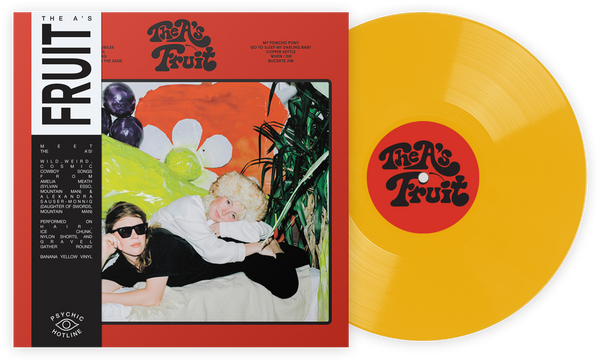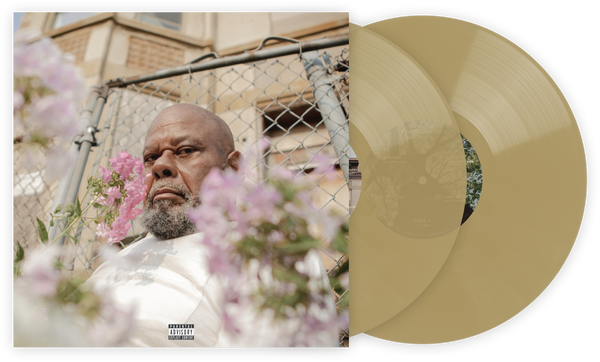Electric Circus: The Common Album Time Still Hasn’t Caught Up To
Our second Rap & Hip Hop selection is Common's Electric Circus. Read the album's liner notes.
I.
When it came to Common Sense, I first found him tucked safely in the mediums of yesteryear. I was a mere 10, deviously flipping through the cable box as if no one could hear me snicker behind the laugh track of what I didn’t understand. It was 2004 and I saw a hungry Mr. West flank Lonnie Lynn on Chappelle’s Show—the one with Ashy Larry at the dice game—and they brought that slick Chitown talk to a screen somewhere in Maryland, forcing me to rewind the tales of hustlenomics and baby mama drama in the City of Wind.
Three years passed: my Aunt Beanie stowed me away on a brief excursion to New York City, just before I started my high school career and right on the cusp of my declaration to sink my life into a notebook. The blogs were my crates, and I scoured them for the now; soon, I’d have to switch between the bootlegs in my Walkman and the PSP that fit like a brick in my pocket. I loaded “Finding Forever” into the brick, and scurried from Queens to the Village to the center of Manhattan that we’ve all seen in the movies. “Start the Show” was the theme song of an autumn en route, and perhaps the rest of my life; that’s a cornball thought from a kid who’s seen too many coming-of-age films.
In 2010, I rode shotgun with Patrick on the way to spit something, somewhere. He was the first poetry mentor I ever had: just over twice my senior, with a soul twice that. He walked the struggle, breathed the hustle, and was more hip-hop than I may ever be. The rest of the night escapes me; the stereo does not. “Electric Wire Hustler Flower” pulverized my eardrums as we crawled the D.C. streets. The refrain, supercharged by an electric guitar and a chorus of angels stirred from their slumber, crashed against my brain as the sunset did our faces. Patrick asked me what I knew of it; clearly, certainly nothing.
But I wondered why the baldhead dude who rapped about the queenpin sounded like this.
II.
As the new millennium approached, Common made his voyage to NYC in search of a new sound, finding himself in the company of ?uestlove, J. Dilla, James Poyser, and Pino Palladino among many other collaborators. As left-field (or so they say) hip-hop held a firm place in the mainstream dialogue, the Soulquarians, informed by the global lineage of Black music and the progressive synergy of the hands and minds within, took a massive responsibility to push the narrative forward at all costs. Electric Lady Studios became their headquarters: the home of the late Jimi Hendrix, and the very studio responsible for several seminal works at the turn of the century. The Roots, Slum Village, D’Angelo, Bilal, and Erykah Badu all crafted classics during this era, favoring a measured dance in the personal, the political, and everywhere they meet. Badu got Mama’s Gun. D’Angelo got Voodoo. The Roots got Things Fall Apart and Phrenology. Common’s first Soulquarian-led effort, Like Water for Chocolate, found its way to a gold plaque and near-universal acclaim for its soulful Afrocentricity and unflinching street tales.
Electric Circus arrived in the last gasps of December 2002. It was a decade out of place, and the universe responded with what felt like a series of punishments: an abysmal #47 Billboard start, one single that barely charted at all, and MCA Records folding under Geffen with seemingly no time to push a work that sounded nothing like the Com Sense that found “The Light.” For all these and more, it’s Common’s second child of the Soulquarian era, and it embodied everything they valued with not a damn in the world to give about who kept up. It wasn’t enough to play the conscious shtick close, riding the momentum of familiar snares and chartered territory to another decoration on the wall. Like his teammates—and the contemporaries found in Missy, Lauryn, and many more—Common’s effort was a calling card to the future and a love note to the revolution ahead.
The beginning of W., the fallout of 9/11 just miles from the studio door, everyone wading in a new chaos. When you can’t contain the mayhem, it threatens to contain you.
III.
A beautiful mayhem can arise from the thirst for more. It serves to explain the reflexive nature of a public’s displeasure and a critic’s disdain; when one serves one’s role so well in the landscape of one’s art, claiming space and fulfilling one’s prophecy in the process, any turn against our understanding can quickly register as a betrayal of everything that made one whole. It’s as if Lonnie Lynn shed his backpack past, as Open Mike Eagle once coined, in one fell swoop, compromising the momentum of his prior successes and drifting a fist pump too far into the otherside. It’s comical to consider the claiming and shaping of a “left-of-center” or “conscious” hip-hop, only to be outcasted even further once an MC’s abstractions don’t ring the way we think they should.
Right down to the Sgt. Pepper cover allusion, reimagined with a sea of Black faces, Electric Circus wastes no time inviting you into its mayhem with a gentle prayer before thrusting you into the driving forces of “Soul Power” and never letting you go until we land in “Heaven Somewhere,” reconciling pain for a chorus of visions for whatever’s waiting once we go. To charge Common as a lost traveler is simply, to begin, a falsehood. While awkward at times, fighting against the current rather than engulfing his flow in the wave, we get the same Common Sense from the ‘90s with a new flair that only aims to prove to himself. The tales of the hustle received a tune-up from the future, complete with all the Afrocentricity and reality-rap storytelling we’re used to. but even Common stopped to acknowledge where the discourse would head.
From “Electric Wire Hustler Flower:”
“I try to walk, but I stumble off the humble path /
This story of a pimp stick that became a staff /
You got it, you gotta know where to aim the Mag /
Art and opinions are made to clash” /
And again, on “New Wave:”
“It’s two ways, living in this world of techno /
This new age can’t really save the ghetto /
I pause for the rebels who rock heavy metals /
And tell them that they pharaoh, so let go”
Posturing aside, anything goes in the Soulquarian sonic universe, and Electric Circus was the blueprint for throwing everything at the wall. Between ?uest, Dilla, Poyser, and Palladino, the traditional boom-bap ethos shifts to background texture over foreground foundation, giving every idea their own spaces to breathe as long as the groove never ceases. The electronic thrill of “New Wave” has electric keys droning like a dying system before giving way to a bright G-funk release with a half-French chorus from Laetitia Sadier, only to transition into a glossy electro jam in “Star *69 (PS with Love),” surging with touchtone-like samples as Bilal and Prince croon about phone sex and enslavement to loneliness. Save for the traditionalist low-hanging fruit of “Come Close”—the Mary J. Blige-assisted single that didn’t move—and relaxed jam band aesthetic of lyrical highlight “Between Me, You & Liberation”—a measured deconstruction of sexual abuse, cancer, and Common’s own homophobia—everything’s drastic in spite of the sacrificed cohesion.
With operating with no guarantees comes the non-negotiable requirement to reconcile with one’s missteps, and Electric Circus had plenty of moments that made no damn sense. That said, in 2002, would you expect to hear Pharrell Williams sing the blues over hard rock while Common flexed his thrift store credibilities long before Macklemore? Was anyone doing eight-minute rock duet tributes to Jimi Hendrix—Common’s first all-singing performance, alongside then-girlfriend Erykah Badu—followed by a dizzying and dazzling 10-minute interrogation of God and the afterlife starring an Electric Lady cast-and-crew that managed to make a whole as good as the sum of its parts? We even got Jill Scott to croon over vaudeville fare, Common personifying the music that keeps us breathing. Again, we got The Artist Formerly Known as Prince soothing us with an ode to dirty talk over the dial tone, a delicacy unbeknownst to a public where the digital equivalent is a mere swipe-and-screenshot away.
IV.
The concision and potency of Common’s earlier work made a swift return on Be, when Kanye arrived with his soul kits and the guitars disappeared. Unlike its counterparts in that Soulquarian era—the Roots, in particular, were celebrated for their progressive efforts, often drawn as the better example of what a push should look like—Electric Circus never got the nod for its strides, many chalking it up among the worst in his career. In 2015, Kendrick Lamar, after the semi-crossover mainstream smash of good kid, m.A.A.d city fast-tracked him to pop stardom, he released To Pimp a Butterfly, bringing jazz and funk to his Compton reportage to near-universal acclaim. Some found it too boring, too high on itself to reach whom it most extends its hand. The latter succeeded far past the former: in turning his lens to the worldview, elevating his art without sacrificing what put him there, K.dot gave us records for the protest, the kickback, and the breakdown over the bottle.
Could this have happened in the popular discourse without an Electric Circus being nearly 13 years its senior? Absolutely not, considering Kendrick’s bloodline running through the Chi in his father, Duck. When Kendrick spoke of the Robert Taylor Homes on “DUCKWORTH.,” or casually mentioned flying his private jet from Rome to a Harold’s alongside Fredo Santana on “Jealous,” it’s impossible not to recall Common’s folklore tracing from Stoney Island to Cottage Grove, stories of Moes and Folks bearing the beauty of the concrete jungle as his Pops, Lonnie Sr., blesses his son with a word to leave the world with on many albums. Two true emcees, giving enough of a damn not to let the spoils of their work stifle the desire for reinvention and revolution. Kendrick’s calculated risk paid dividends, but Common’s did as well: to assemble a massive vision under the helm of legends? To find the new wave and crash within, only to resurface and crash again? Accomplished nonetheless, both men siphoning the triumph from turmoil to broadcast their plea for a new, Black world on the horizon.
Perhaps it’s the Southside in them. You wish they would give you this feeling.
You can start signing up to receive Common as part of your monthly pacakge from Vinyl Me, Please. Add yourself to the waitlist, and after Sept 15, you'll be added to the side subscription.
Add Rap & Hip-Hop to my membership Notify me when Rap & Hip-Hop becomes available to the public
Michael Penn II (aka CRASHprez) is a rapper and a former VMP staff writer. He's known for his Twitter fingers.





